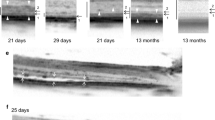Abstract
Photoelectric dye-coupled polyethylene film, designated Okayama University-type retinal prosthesis or OUReP™, generates light-evoked surface electric potentials and stimulates neurons. In this study, the vision was assessed by behavior tests in aged hereditary retinal dystrophic RCS rats with OUReP™, retinal apoptosis and electroretinographic responses were measured in dystrophic eyes with OUReP™. The dye-coupled films, or plain films as a control, were implanted in subretinal space of RCS rats. On behavior tests, RCS rats with dye-coupled films, implanted at the old age of 14 weeks, showed the larger number of head-turning, consistent with clockwise and anticlockwise rotation of a surrounding black-and-white-striped drum, compared with rats with plain films, under the dim (50 lux) and bright (150 lux) conditions in the observation period until the age of 22 weeks (n = 5, P < 0.05, repeated-measure ANOVA). The number of apoptotic cells in retinal sections at the site of dye-coupled film implantation was significantly smaller, compared with the other retinal sites, neighboring the film, or opposite to the film, 5 months after film implantation at the age of 6 weeks (P = 0.0021, Friedman test). The dystrophic eyes of RCS rats with dye-coupled films showed positive responses to maximal light stimulus at a significantly higher rate, compared with the eyes with no treatment (P < 0.05, Chi-square test). Electroretinograms in normal eyes of Wistar rats with dye-coupled or plain films showed significantly decreased amplitudes (n = 14, P < 0.05, repeated-measure ANOVA). In conclusions, vision was maintained in RCS rats with dye-coupled films implanted at the old age. The dystrophic eyes with dye-coupled films showed electroretinographic responses. Five-month film implantation caused no additional retinal changes.





Similar content being viewed by others
References
Loewenstein JI, Montezuma SR, Rizzo JF III. Outer retinal degeneration: an electronic retinal prosthesis as a treatment strategy. Arch Ophthalmol. 2004;122:587–96.
Zrenner E. Will retinal implants restore vision? Science. 2002;295:1022–5.
Chow AY, Chow VY, Packo KH, Pollack JS, Peyman GA, Schuchard R. The artificial silicon retina microchip for the treatment of vision loss from retinitis pigmentosa. Arch Ophthalmol. 2004;122:460–9.
Humayun MS, Dorn JD, da Cruz L, Dagnelie G, Sahel JA, Stanga PE, Cideciyan AV, Duncan JL, Eliott D, Filley E, Ho AC, Santos A, Safran AB, Arditi A, Del Priore LV, Greenberg RJ; Argus II Study Group. Interim results from the international trial of Second Sight’s visual prosthesis. Ophthalmology. 2012;119:779–88.
Matsuo T. A simple method for screening photoelectric dyes towards their use for retinal prostheses. Acta Med Okayama. 2003;57:257–60.
Uchida T, Ishimaru S, Shimamura K, Uji A, Matsuo T, Ohtsuki H. Immobilization of photoelectric dye on the polyethylene film surface. Mem Fac Eng Okayama Univ. 2005;39:16–20.
Matsuo T, Dan-oh Y, Suga S (Inventors). Agent for inducing receptor potential. Assignee: Okayama University. United States Patent. Patent No.: US 7,101,533 B2. Date of Patent: 5 Sept 2006.
Uji A, Matsuo T, Ishimaru S, Kajiura A, Shimamura K, Ohtsuki H, Dan-oh Y, Suga S. Photoelectric dye-coupled polyethylene film as a prototype of retinal prostheses. Aritif Org. 2005;29:53–7.
Uji A, Matsuo T, Uchida T, Shimamura K, Ohtsuki H. Intracellular calcium response and adhesiveness of chick embryonic retinal neurons to photoelectric dye-coupled polyethylene films as prototypes of retinal prostheses. Artif Org. 2006;30:695–703.
Tamaki T, Matsuo T, Hosoya O, Tsutsui KM, Uchida T, Okamoto K, Uji A, Ohtsuki H. Glial reaction to photoelectric dye-based retinal prostheses implanted in the subretinal space of rats. J Artif Org. 2008;11:38–44.
Okamoto K, Matsuo T, Tamaki T, Uji A, Ohtsuki H. Short-term biological safety of a photoelectric dye used as a component of retinal prostheses. J Artif Org. 2008;11:45–51.
Matsuo T, Uchida T, Takarabe K. Safety, efficacy, and quality control of a photoelectric dye-based retinal prosthesis (Okayama University-type retinal prosthesis) as a medical device. J Artif Org. 2009;12:213–25.
Matsuo T, Morimoto N. Visual acuity and perimacular retinal layers detected by optical coherence tomography in patients with retinitis pigmentosa. Br J Ophthalmol. 2007;91:888–90.
Tamaki M, Matsuo T. Optical coherence tomographic parameters as objective signs for visual acuity in patients with retinitis pigmentosa, future candidates for retinal prostheses. J Artif Org. 2011;14:140–50.
Alamusi, Matsuo T, Hosoya O, Tsutsui KM, Uchida T. Behavior tests and immunohistochemical retinal response analyses in RCS rats with subretinal implantation of Okayama-University-type retinal prosthesis. J Artif Org. 2013;16:343–51.
Dowling JE, Sidman RL. Inherited retinal dystrophy in the rat. J Cell Biol. 1962;14:73–109.
Cuenca N, Pinilla I, Sauve Y, Lund R. Early changes in synaptic connectivity following progressive photoreceptor degeneration in RCS rats. Eur J Neurosci. 2005;22:1057–72.
Pardue MT, Phillips MJ, Yin H, Sippy BD, Webb-Wood S, Chow AY, Ball SL. Neuroprotective effect of subretinal implants in the RCS rat. Invest Ophthalmol Vis Sci. 2005;46:674–82.
Conflict of interest
The authors declare that they have no conflict of interest.
Author information
Authors and Affiliations
Corresponding author
Rights and permissions
About this article
Cite this article
Alamusi, Matsuo, T., Hosoya, O. et al. Vision maintenance and retinal apoptosis reduction in RCS rats with Okayama University-type retinal prosthesis (OUReP™) implantation. J Artif Organs 18, 264–271 (2015). https://doi.org/10.1007/s10047-015-0825-1
Received:
Accepted:
Published:
Issue Date:
DOI: https://doi.org/10.1007/s10047-015-0825-1




